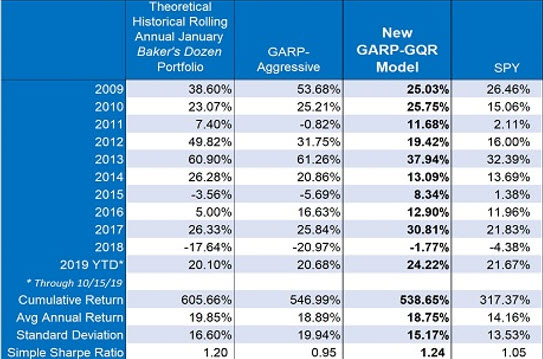Growth Quality Rank (GQR)

Sabrient founder David Brown and his team have developed a new Growth Quality Rank (GQR) factor to introduce as an enhancement into our long-standing GARP (“growth at a reasonable price”) quantitative model. In addition to the magnitude of expected growth, relative valuation, corporate integrity, and earnings quality factors on which we have long focused our GARP model and portfolio selection approach, GQR helps us focus on those companies with consistent and reliable earnings growth and an elevated likelihood of achieving consensus sell-side growth estimates. In other words, we believe GQR will help us achieve better “all-weather” performance, even during times when investor sentiment seems “irrational,” or misaligned with the fundamental outlook.
Background
Sabrient developed its long-standing GARP model in 2008 and soon began using it as the basis for selecting the Baker’s Dozen annual “top picks list” (starting with the published 2009 portfolio). In 2011, Sabrient acquired Gradient Analytics, a forensic accounting research firm, and collaborated to develop an Earnings Quality Rank (EQR) as an enhancement to the GARP model to better focus on companies with less aggressive accounting practices relative to their industry peers. Similarly, the new Growth Quality Rank (GQR) will help us to focus on those companies with more consistent and reliable earnings growth trends that we believe are more likely to achieve their growth forecasts.
GQR was developed specifically in response to the anomalous market conditions and seemingly irrational price moves (as opposed to changing fundamentals) for the June 2018 through August 2019 timeframe when an historic valuation bubble formed in low-volatility/defensive/large-caps over value/cyclical/small-mid-caps.
Test Results
Our historical testing suggests that GQR would have been a valuable enhancement starting in mid-2015, when the last presidential election campaign kicked into gear, the Fed announced its intention to begin a monetary tightening cycle, and China admitted to growth challenges.
Importantly, our testing further suggests that the enhanced GARP-GQR model should reduce the volatility (and downside capture) in Sabrient’s portfolios when adverse and unexpected market conditions arise without significantly reducing the upside potential that investors seek from Sabrient.
